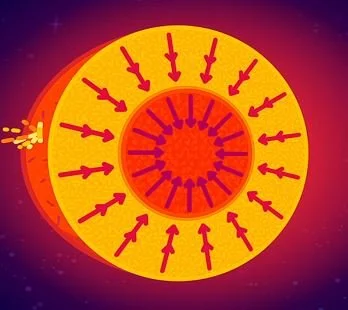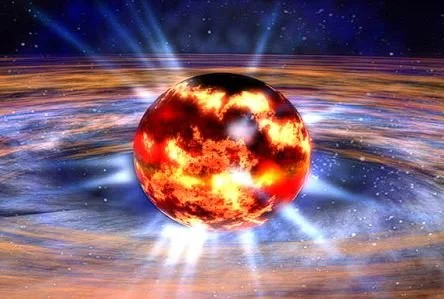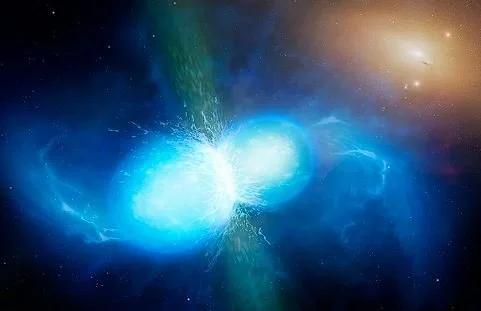Neutron Stars: From Supernovae to Kilonovae
Written By: Kesavan Rangarajan
Neutron stars are the remains of dead stars. Stars exist as a balance between gravity and the outward force of fusion. Gravity compresses the hydrogen towards the core of the star; the fusion reactions create energy that pushes against gravity. This state of equilibrium is what keeps stars alive. At the end of their lifespan, most of the hydrogen has been fused into helium. This causes the number of fusion reactions to decrease, allowing gravity to take over. However, as the star compresses, the core becomes hot enough for the helium at its center to fuse into carbon. When this helium runs out, the star compresses again, fusing the carbon to neon. This process occurs until the core is made up of iron. Fusing iron utilizes far more energy than it releases. Stars could partially fight gravity, but without the fusion of iron, gravity wins.
An animation of gravitational force overwhelming the fusion power of a star (Neutron Stars – The Most Extreme Things That Are Not Black Holes.)
At these high temperatures and pressures, the atom itself breaks. Normally, electrons orbit around the nucleus of an atom, and these particles do not like being pushed together. However, due to the tremendous pressure at the core, the protons and electrons fuse together forming neutrons. These neutron clusters get packed together since the pressure formed by the weight of the star overcomes the forces pushing them apart. This compresses a neutron star from 2.5 times the mass of our sun to a sphere the size of an urban city. But the core isn’t the only thing that condenses.
Gravity pulls the outer layers of the star inwards at speeds of up to 25% of the speed of light, or 74 million meters per second. Iron bounces off the core, sending a shockwave throughout the universe that can be brighter than entire galaxies.
An animation of a supernova. (Neutron Stars – The Most Extreme Things That Are Not Black Holes.)
Neutron stars have a gravitational pull second only to black holes; if they were any denser, they would become one. This gravitational pull can even bend light. Light bends around the neutron star, allowing an observer to see both its front and back at the same time. Inside a neutron star is something very unexpected. Neutron stars are stars, of course, yet their overall structure is similar to a planet. They have an atmosphere, a crust, and a core. The atmosphere reaches temperatures of around a MILLION °C, compared to the 6,000 °C of the Sun’s outer layer. The crust is made up of neutrons squeezed into a crystal lattice shape with tons of electrons flowing about. As you go deeper into the crust, the force of gravity pulls the neutrons closer and closer together. Once you reach the bottom of the crust, the nuclei start to touch. This is called the Gnocchi phase. Then the protons and neutrons move around, forming sheets of nuclei in the Spaghetti and Lasagna phases. The extremely original and unique physicists call this Nuclear Pasta. Nuclear Pasta is so dense that one sugar cube worth would weigh as much as Mount Everest. That’s over a BILLION tons!
An animated image of nuclear pasta. (Neutron Stars – The Most Extreme Things That Are Not Black Holes.)
Another important aspect of neutron stars is their spin. Young neutron stars spin at incredible rates, rotating multiple times per second. Their magnetic fields are trillions of times stronger than Earth’s, so when they rotate, they emit pulses of radio waves that form cones at the poles. These neutron stars are called pulsars. Astronomers have only found less than 2,000 of these pulsars, even though there should be a billion stars in our galaxy. This is most probably because most neutron stars are extremely old. As they age, they cool down and spin slower. This prevents them from emitting radio waves as pulsars do.
NASA image of a pulsar (Dunbar)
Now the most important thing that neutron stars do involves making friends. When two neutron stars are next to each other, they start to orbit one another. They revolve around each other until they collide. Upon colliding, most of the contents of the star are exploded outwards in what is known as a kilonova. At this point, the conditions inside the star fuse atomic nuclei again, just like fusion. However, these neutrons and protons don’t rearrange perfectly. Instead, they rearrange in random ways, different for each nucleus. Physicists hypothesize that this is probably the origin of most of the heavy metals in the universe. Basically, almost everything around you was formed by stars dying, not once, but twice.
Artwork of two neutron stars merging, then exploding as a kilonova (The Alchemy of Neutron Stars.) © University of Warwick/Mark Garlick/ESO
Works Cited
“The Alchemy of Neutron Stars.” The Alchemy of Merging Neutron Stars | Max-Planck-Gesellschaft, 23 Oct. 2019, https://www.mpg.de/14032050/1018-astr-053792-the-alchemy-of-merging-neutron-stars.
Dunbar, Brian. “Neutron Stars.” NASA, NASA, https://www.nasa.gov/image-feature/neutron-stars-collide/ Accessed 14 Sept. 2023.
“Imagine the Universe.” NASA, NASA, https://imagine.gsfc.nasa.gov/ Accessed 14 Sept. 2023.
“Neutron Stars – The Most Extreme Things That Are Not Black Holes.” YouTube, 10 Nov. 2019, https://www.youtube.com/watch?v=udFxKZRyQt4&list=LL&index=7&t=158s.%20Accessed%2014%20Sept.%202023.




